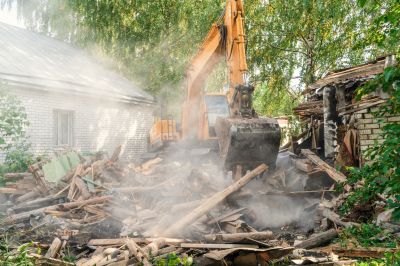Favorite Equipment for Demolition Service Contractors
Learn which tools and machinery are preferred by industry experts for delivering reliable and efficient demolition services.
 Demolition projects in Bettendorf, IA, require a diverse array of equipment and tools to ensure efficiency and safety. From small-scale interior demolitions to large structural removals, having the right products is essential for successful outcomes. Proper selection of demolition tools can help minimize damage to surrounding structures, reduce labor time, and improve overall project management. Whether working on residential, commercial, or industrial sites, understanding the available products and their applications is vital for contractors and DIY enthusiasts alike.
Demolition projects in Bettendorf, IA, require a diverse array of equipment and tools to ensure efficiency and safety. From small-scale interior demolitions to large structural removals, having the right products is essential for successful outcomes. Proper selection of demolition tools can help minimize damage to surrounding structures, reduce labor time, and improve overall project management. Whether working on residential, commercial, or industrial sites, understanding the available products and their applications is vital for contractors and DIY enthusiasts alike.
Top Overall Option
Heavy-Duty Excavator with Demolition Attachments
A versatile piece of machinery that can be equipped with a variety of attachments such as hydraulic breakers, shears, and grapples. This equipment provides the power and adaptability needed for large-scale demolition projects, offering efficiency and precision. Its robust construction and advanced control systems make it suitable for handling different materials and structural components safely. Proper training and safety measures are essential when operating such machinery to maximize its benefits.
Types of Products For Demolition Service
Hydraulic Breakers
Powerful tools used to break concrete, asphalt, and other hard materials, often attached to excavators.
Demolition Hammers
Handheld pneumatic or electric tools designed for breaking up concrete and masonry in smaller or detailed demolition work.
Sledgehammers
Traditional manual tools ideal for light demolition tasks and breaking smaller structures.
Grapples and Clamshell Buckets
Attachments for excavators that facilitate material handling and debris removal.
Wrecking Balls
Heavy steel balls used for bringing down large structures, primarily in older demolition methods.
Dust Suppression Systems
Equipment designed to control dust during demolition, improving safety and visibility.
Concrete Crushers
Machines that crush concrete debris into manageable sizes for recycling or disposal.
Skid Steer Loaders
Compact machines with various attachments suitable for small to medium demolition tasks.
Cutting Saws
Power tools used for precise cuts in metal, concrete, or other materials during demolition.
Safety Gear
Protective equipment including helmets, gloves, goggles, and respirators to ensure worker safety.
Portable Generators
Power sources that support electric tools and equipment on job sites without permanent power supplies.
Lifting and Rigging Equipment
Tools and gear used to lift heavy materials safely and efficiently during structural dismantling.
Popular Choices
Widely used for their portability and ease of use in breaking concrete and masonry.
Versatile attachments that expand the capabilities of standard excavators for demolition tasks.
Lightweight and effective for breaking up concrete and asphalt in various environments.
Effective for reducing airborne dust during demolition, improving site safety.
Essential for prying and leverage work in demolition projects.
Power tools favored for their accuracy in cutting through reinforced concrete.
Popular for their adaptability and maneuverability in tight spaces.
Containers designed for efficient debris collection and transport on demolition sites.
Common safety gear used universally across demolition sites for protection.
Lighting solutions to ensure visibility during work in low-light conditions.
Attachments that enable precise cutting and removal of metal structures.
Machines that facilitate on-site recycling of concrete and other materials.
Equipment used for safe lifting and placement of heavy structural components.
Heavy-duty machinery such as excavators equipped with specialized attachments are often central to larger demolition tasks. These machines can handle substantial structural components and provide the power needed for more demanding projects. For smaller or more precise demolitions, handheld tools like sledgehammers, demolition hammers, and pneumatic tools offer flexibility and control. Safety equipment, including protective gear and dust suppression systems, complements these tools to promote a safer working environment.
Choosing the right products involves considering the scope of the project, the materials involved, and the working environment. Durability and ease of use are important factors, as well as compatibility with existing equipment. Proper maintenance and handling procedures are also critical to ensure longevity and safety during operation. With a wide range of products available, contractors in Bettendorf can find solutions tailored to their specific demolition needs, whether for residential renovations, commercial tear-downs, or industrial dismantling projects.
Key Buying Considerations
- Project scope and scale to determine appropriate equipment size and capacity.
- Material types involved, such as concrete, steel, or wood, to select suitable tools.
- Power source preferences, including electric, pneumatic, or hydraulic options.
- Ease of operation and user training requirements for safety and efficiency.
- Durability and build quality to withstand demanding demolition environments.
- Compatibility with existing equipment and attachment systems.
- Safety features and compliance with local safety regulations.
- Portability and ease of transport for site-to-site mobility.
- Maintenance requirements and availability of replacement parts.
- Budget constraints balanced with the need for reliable performance.
- Environmental considerations like dust suppression and noise levels.
- Availability of technical support and customer service.
- Versatility of equipment for different types of demolition tasks.
- Storage and storage space for tools and machinery on-site.
- Potential for on-site recycling or debris management capabilities.
